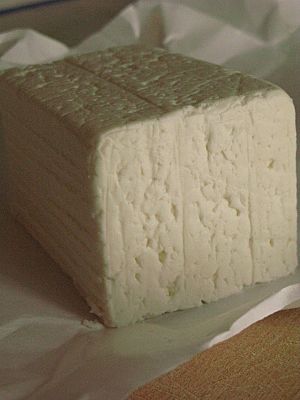Quartirolo Lombardo facts for kids
Quick facts for kids Quartirolo Lombardo |
|
|---|---|
 |
|
| Country of origin | Italy |
| Region | Lombardy |
| Town | Provinces of Bergamo, Brescia, Como, Cremona, Lecco, Lodi, Milano, Monza, Pavia and Varese |
| Source of milk | Cows |
| Certification | PDO |
| Named after | Lua error in Module:Wikidata at line 70: attempt to index field 'wikibase' (a nil value). |
Quartirolo Lombardo is a soft and delicious table cheese from Italy. It is made using cow's milk. This cheese has a special status called Protected Designation of Origin (PDO). This means it can only be made in certain parts of Italy. It also must follow traditional methods to get its unique taste and quality.
Contents
History of Quartirolo Lombardo
This special cheese has a very long history! People started making Quartirolo Lombardo way back in the 10th century. For a long time, it was a seasonal cheese. Farmers only made it at the end of summer. They used milk from cows that had eaten a special type of grass. This grass was called "erba quartirola". This means "grass of the fourth" in Italian. It was the fresh grass that grew after the third time the fields were cut that year.
Today, you can enjoy Quartirolo Lombardo cheese all year round. It has been officially recognized by the European Economic Community. It is now on the list of protected products.
Where Quartirolo Lombardo is Made
Quartirolo Lombardo cheese comes from the beautiful Lombardy region in Italy. The milk used for this cheese must come from cows in this area. Also, the cheese itself must be made and aged in specific places. These places include the provinces of Bergamo, Brescia, Como, Cremona, Lecco, Lodi, Milano, Monza, Pavia and Varese.
What Quartirolo Lombardo Looks Like
Quartirolo Lombardo cheese usually has a rectangular shape. A single cheese wheel can weigh between 1.5 kg (about 3.3 pounds) and 3.5 kg (about 7.7 pounds). The outside of the cheese, called the rind, is thin and soft. When the cheese is young, the rind is white or has a pinkish color. As the cheese gets older, the rind might turn a grey-green or reddish color.
The inside of the cheese is called the curd. When the cheese is young, the curd is soft and can be a bit crumbly. It might have a few small gaps. As the cheese gets older, the curd becomes more compact and even softer. The color of the cheese inside ranges from white to a light straw color. Older cheese might have a deeper, more intense color.
How Quartirolo Lombardo Tastes
The flavor of Quartirolo Lombardo is very special. When the cheese is young, it tastes slightly sour and fresh. It has a nice, mild smell. As the cheese gets older, its flavor becomes stronger and more aromatic. It develops a richer, more intense taste. This cheese is also quite healthy. It has at least 30% fat in its dry material. This is true for cheese made from semi-skimmed milk.
How Quartirolo Lombardo is Made
Making Quartirolo Lombardo is a careful process. It uses whole or semi-skimmed cow's milk. This milk comes from two or more milkings.
Coagulation and Curd Breaking
First, the milk is warmed to about 35°C to 40°C (95°F to 104°F). Then, rennet from a calf is added. This makes the milk thicken, a process called coagulation. This takes about 25 minutes. Sometimes, a special milk starter culture is added. This helps the cheese develop its flavor. It must be made at the same cheese factory.
Next, the thick curd is broken into smaller pieces. This is done in two steps. The cheesemakers watch how the whey changes. After the second breaking, the curd pieces are about the size of a hazelnut.
Shaping and Salting
The cheese mixture, along with some whey, is then put into special molds. These molds help shape the cheese. The cheese is then left to rest in a warm place. This "stewing" process happens at about 26°C to 28°C (79°F to 82°F). It can last anywhere from 4 to 24 hours.
After shaping, the cheese is salted. This can be done in two ways. It can be dry salted, where salt is rubbed on the outside. Or, it can be placed in a brine bath, which is a salty water solution.
Aging the Cheese
Finally, the cheese goes into special rooms to age. These rooms are kept cool, between 2°C and 8°C (36°F and 46°F). They also have high humidity, around 85-90%. The aging time depends on the type of cheese. For the soft version, it ages for 5 to 30 days. If it ages for more than 30 days, it is sold as "aged Quartirolo Lombardo." No special treatments are allowed on the rind of the cheese.
Nutritional Value
| Nutritional value per 100 g (3.5 oz) | |
|---|---|
| Energy | 1,240 kJ (300 kcal) |
|
0 g
|
|
|
24.5 g
|
|
|
Protein
|
18,5 g
|
| Vitamins | Quantity
%DV†
|
| Vitamin A equiv. |
42%
336 μg |
| Riboflavin (B2) |
18%
0.220 mg |
| Minerals | Quantity
%DV†
|
| Calcium |
57%
572 mg |
| Magnesium |
6%
21.8 mg |
| †Percentages estimated using US recommendations for adults. | |
See also
 In Spanish: Quartirolo Lombardo para niños
In Spanish: Quartirolo Lombardo para niños

